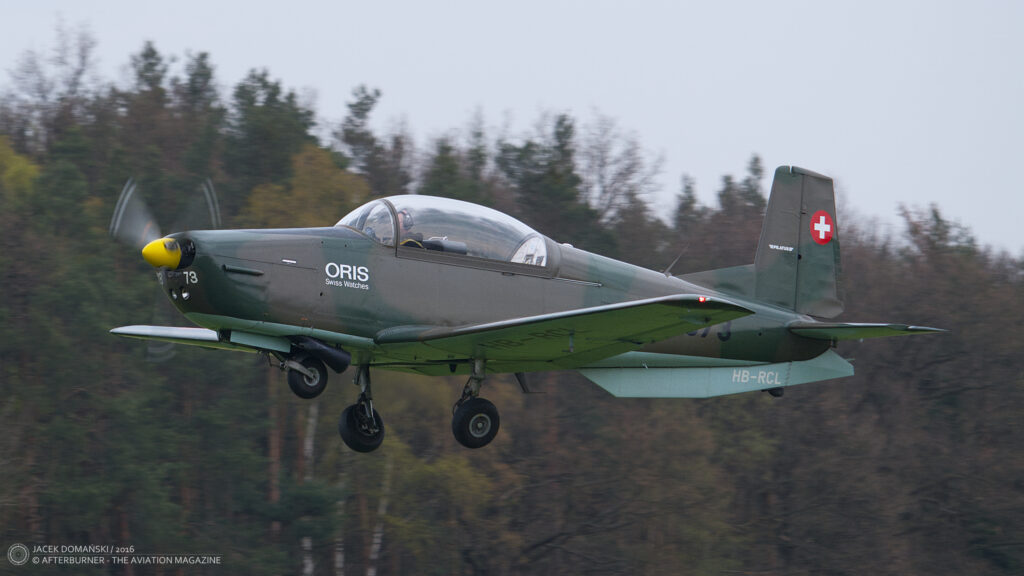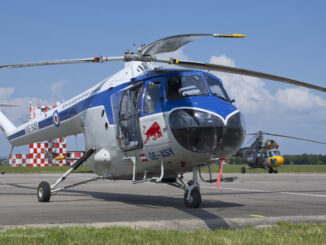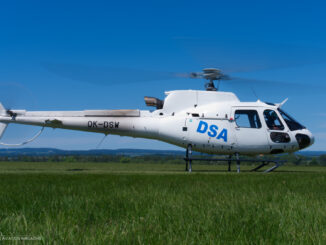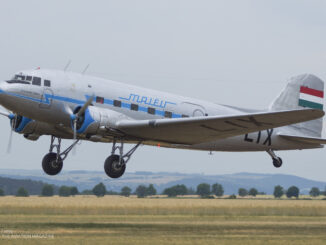 Pilatus P-3-05 (c/n 511-60, HB-RCL of the P-3 Flyers aerobatic team, formerly A-873 of the Swiss Air Force), flying display at Den ve vzduchu air show, Plasy, April 2016.
Pilatus P-3-05 (c/n 511-60, HB-RCL of the P-3 Flyers aerobatic team, formerly A-873 of the Swiss Air Force), flying display at Den ve vzduchu air show, Plasy, April 2016.
In the early 1950s, increasing popularity of jet-powered fighters required introduction of the next generation of military training aircraft. They had to be developed following the concept of versatile trainer, allowing the cadets to complete the full pilot´s course and then easily switch to a jet combat aeroplane.
Switzerland was no exception from that rule. Yet in 1949, the country´s air force acquired its first jet fighter – de Havilland Vampire, followed by de Havilland Venom (1954) and then Hawker Hunter (1958). It meant that the Swiss Air Force also needed a new trainer and, therefore, the Pilatus company began works on development of the new, two-seat training aeroplane.
The project, officially designated Pilatus P-3, was shaped in 1952. The new trainer had to be equipped with tricycle landing gear, as well as to feature similar take-off and landing characteristics as the jet fighter.
On 3rd September 1953, prototype of the new aircraft took-off for its maiden flight. The P-3 was a cantilever, low-wing monoplane of all metal construction. Its two ejection seats were placed in a tandem configuration, under a joint canopy. The aeroplane was intended for primary and advanced training, capable of night-time and instrument flights, as well as performing aerobatics.
Evaluation flights of the new trainer lasted about a year and resulted in implementing several construction changes, primarily a new powerplant with better performance – Lycoming GO-435-C2A, six-cylinder piston engine, generating 240 hp.
After the introduction of the abovementioned changes, the Swiss Air Force ordered the first batch of twelve aircraft, designated P-3-03, to be manufactured until the end of 1956. The aircraft from that test series were well-received by the Swiss training units and in conclusion, the main series of sixty P-3-05 trainers was ordered in 1957.
The P-3 was the basic Swiss military trainer for approximately two decades, until introduction of Pilatus P-7 – the new, turboprop trainer developed by Pilatus directly from the P-3 concept. An interesting fact is that the first prototype of the P-7 was created by re-building one of the Pilatus P-3 aircraft.
Nevertheless, introduction of the new turboprop trainer did not mean a retirement for the P-3. The aircraft was still used by the Swiss Air Force as a liaison aeroplane until the early 1990s. Then, the majority of surviving P-3s were decommissioned and sold to civilian operators.
In 1963, the Brazilian naval aviation acquired six Pilatus P-3 aircraft. The aeroplanes were delivered until 1965 and remained in active service until 1972. That Brazilian contract was the sole export sales of the P-3.
Nowadays, the P-3 remains a popular warbird and is being operated by various civilian users. Among them, there is the P3 Flyers aerobatic group, based in Ambrì–Piotta, Switzerland. The team was founded in 1992, following the purchase of its first Pilatus P-3, but had its public premiere in 1996, at that time flying with just two aircraft.
Since 2006, the team was flying with five P-3, representing different painting schemes formerly used by the Swiss Air Force. In 2016, the P3 Flyers visited the Czech Republic and performed their aerobatic show at Den ve vzduchu air show in Plasy, West Bohemia – where our current Photo of the Week was taken.


